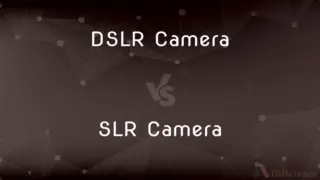Braids vs. Plaits — What's the Difference?
By Tayyaba Rehman — Published on December 21, 2023
Braids and plaits both refer to interweaving strands of hair or material. In American English, "braids" is more common, while "plaits" is prevalent in British English.

Difference Between Braids and Plaits
Table of Contents
ADVERTISEMENT
Key Differences
Braids and plaits are terms that are often used interchangeably, but they have subtle distinctions in usage depending on regional language differences. In American English, the term "braids" is predominantly used to describe the process of interweaving three or more strands of hair or any other material. On the other hand, "plaits" holds a similar meaning but is more popularly used in British English contexts.
Both braids and plaits have rich histories, with records of their existence dating back thousands of years. While braids have been central to various cultures around the world, from African tribal designs to Scandinavian traditional hairstyles, plaits, by British definition, share the same global historical presence.
Furthermore, braids and plaits have evolved over time to signify different cultural, social, or even political meanings. In many communities, braids can symbolize age, marital status, or social position. Similarly, plaits, as understood in the UK, can hold significant cultural symbols, representing traditions and histories.
In the realm of fashion and hair styling, both braids and plaits are considered trendy and timeless. While braids, especially in the US, might refer to anything from cornrows to box braids, plaits in British settings might signify styles like the classic three-strand weave or even fishtail designs.
Lastly, outside of hair, both terms can be used in contexts like crafting or creating textiles. For instance, you might find braids on the trims of garments or as decorative elements on bags. Similarly, plaits can be understood as interwoven materials in arts and crafts in the UK.
ADVERTISEMENT
Comparison Chart
Regional Usage
Predominantly American English
Predominantly British English
Number of Strands
Can be three or more
Typically three but can vary
Cultural Significance
Seen in various cultures (e.g., African, Nordic)
Similar global presence, especially in the UK
Applications
Hair styling, crafts, textiles
Hair styling, crafts, textiles
Modern Fashion Reference
Cornrows, box braids, etc.
Classic three-strand weave, fishtail, etc.
Compare with Definitions
Braids
A pattern formed by intertwining.
The rug had colorful braids around the edge.
Plaits
A single length of hair or other flexible material made up of three or more interlaced strands.
She fashioned her hair into two plaits.
Braids
A cord or ribbon used as decoration.
The dress was adorned with golden braids.
Plaits
A method of gathering or folding.
She put her hair in plaits for the festival.
Braids
A quick way to style long hair.
She put her hair in braids before the workout.
Plaits
Interlaced strands, typically of hair.
Her plaits dangled past her shoulders.
Braids
A binding or uniting force.
Friendship is the braid that keeps us together.
Plaits
A design of parallel folds.
The shirt had plaits down the front.
Braids
Interwoven strands of hair or material.
She wore her hair in tight braids.
Plaits
A long, narrow strip of fabric used for decoration.
The curtain had delicate plaits as trim.
Braids
To interweave three or more strands, strips, or lengths of in a diagonally overlapping pattern
Braided the rags into a strong rope.
Plaits
A braid, especially of hair.
Braids
To create (something) by such interweaving
Braid a rug.
Plaits
A pleat.
Braids
To style (the hair) by such interweaving.
Plaits
To braid.
Braids
To mingle (discrete elements, for example) as if by such interweaving
Braided the ideas into a complex thesis.
Plaits
To pleat.
Braids
To decorate or edge (something) with a trim of interwoven strands
Finished the jacket by braiding the collar and cuffs.
Plaits
To make by braiding.
Braids
To fasten or decorate (hair) with a band or ribbon.
Plaits
Plural of plait
Braids
To flow, twist, or wind as if interwoven
A stream braiding through the woods.
Plaits
Infl of plait
Braids
A braided segment or length, as of hair, fabric, or fiber.
Braids
Ornamental cord or ribbon, used especially for decorating or edging fabrics.
Braids
A ribbon or band used to fasten the hair.
Braids
Plural of braid
Braids
Infl of braid
Common Curiosities
How many strands are typically in a plait?
Plaits typically have three strands but can vary.
How many strands are in a braid?
Braids can have three or more strands.
What's the primary context for plaits in the UK?
Plaits usually refer to interwoven hair but can also mean woven materials.
Are braids and plaits the same?
Essentially, yes. Both refer to interweaving strands, but "braids" is common in American English and "plaits" in British English.
Can plaits be used in fashion?
Yes, plaits are both a hairstyle and a design element in fashion.
How long does it take to braid hair?
It varies based on length, thickness, and braid style.
Are plaits seen in modern hairstyles?
Absolutely, plaits remain a trendy hairstyle choice.
Can braids be of any material?
Yes, braids can be of hair, fabric, or any flexible material.
Are there different types of braids?
Yes, including but not limited to cornrows, box braids, and French braids.
Are braids significant culturally?
Yes, braids hold cultural significance in various societies.
Can the term braids be used outside of hair contexts?
Yes, braids can refer to intertwined materials in crafts and textiles.
Is "plaiting" the act of creating plaits?
Yes, "plaiting" refers to the process of making plaits.
Can you braid with two strands?
Typically, braids have three or more, but two-strand styles are called "twists."
Do plaits have a historical presence in the UK?
Yes, plaits have been a part of UK history and traditions.
Are plaits strictly a British term?
Predominantly, but the term can be understood elsewhere, especially with context.
Share Your Discovery

Previous Comparison
Sale vs. Hire Purchase
Next Comparison
DSLR Camera vs. SLR CameraAuthor Spotlight
Written by
Tayyaba RehmanTayyaba Rehman is a distinguished writer, currently serving as a primary contributor to askdifference.com. As a researcher in semantics and etymology, Tayyaba's passion for the complexity of languages and their distinctions has found a perfect home on the platform. Tayyaba delves into the intricacies of language, distinguishing between commonly confused words and phrases, thereby providing clarity for readers worldwide.













































